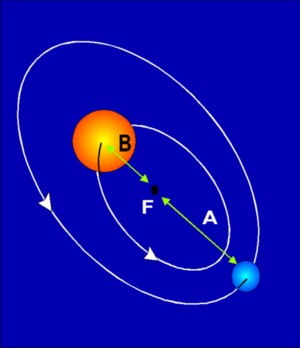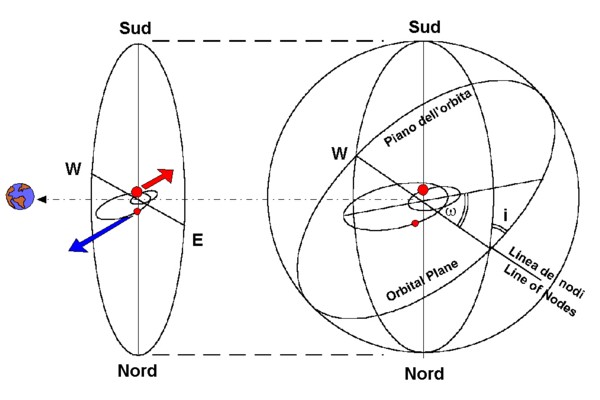SPECTROSCOPIC BINARIES
Introduction
- b Aur
Introduction
A binary star is shown in picture 1. Each of the two components move around the center
of mass of the system. Orbits are elliptical with the same excentricity in such a way
that the two stars lie on a line passing throught the center of mass.

|
Picture 1: In a binary star, each component rotate around the center of mass on
elliptical orbits with the same excentricity.
The bigger star rotates closer to the center of mass.
|
The ratio between the distances of the two stars from the center of mass is inversely
proportional to the mass of each star. That is to say:
A/B=MB/MA
If we measure the distances in UA, the mass in solar masses and the time in tropic years,
the third Kepler law for a double system become:
(MA+MB)=a3/P2
From the previous formula we see that massive stars that are not too far from each other
have short rotation periods and thus high rotation speed.
A good example is the star Spica, whose components are B1 and B3 stars, only 0,126 AU apart.
Tge measured period is 4,014 days that brings to an orbital speed for the components of
120 and 189 Km/sec. Such high speeds can be easily measured by the Doppler shift.
The wavelenght Doppler shift from a moving source is given by:
Dl/l=c/v
where c is the speed of light and v is the speed of the source.
Thus, in the case of Spica, we can observe a maximum line separation of the lines of the
two components (relative speed v=120+189 Km/sec) of 5 ┼ around 5000 ┼
(our spectrograph can reach a 0.5 ┼ resolving power).

|
|
Picture 2: The apparent binary orbit observed from earth (at left) and the real orbit
as seen in 3D space (at right).
|
As it is shown in picture 2, the Doppler effect due to orbital motion can be reduced by
a factor sin (i) due to the inclination of the orbital plane respect to the line
of sight.
As we have no information concerning the inclination angle i of the orbit, we can
only state that the Doppler speed is a lower limit for the real orbital speed.
From the 3rd Kepler law, we can thus deduce only an upper limit for the stellar masses.
Only in some cases it is possible to measure the orbital inclination from interferometry
or from the periodical eclipses that happens when the angle i approaches 90 degrees.
It should also be noted that often it is not possible to see the lines of of both stars
in the spectrum because one is much fainter than the other.
In this case it is important to make precise abolute measurements using calibration lamps
in order to appreciate the small periodical periodical shift of the lines.
Goto double stars spectra:
b Aur
|
|


